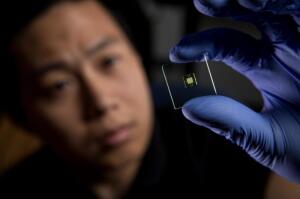by
Lauren Dubinsky, Senior Reporter | August 21, 2017

The 3-D-printed microfluidic device
Courtesy of BYU
Researchers at Brigham Young University in Utah created a new type of lab-on-a-chip device.
These chips, also known as microfluidic devices, extract disease biomarkers, cells and other small structures from samples of blood with their microscopic channels.
The team was recently the first to 3-D print a viable microfluidic device that's small enough to be effective at a scale much less than 100 micrometers. This is a major step toward mass-producing these devices cheaply.



Ad Statistics
Times Displayed: 79541
Times Visited: 2807 Ampronix, a Top Master Distributor for Sony Medical, provides Sales, Service & Exchanges for Sony Surgical Displays, Printers, & More. Rely on Us for Expert Support Tailored to Your Needs. Email info@ampronix.com or Call 949-273-8000 for Premier Pricing.
Others have 3-D printed fluidic channels, but they haven't been able to design them small enough for microfluidics.
In an article published online in the journal
Lab on a Chip, the researchers explained that this was made possible because they build their own high resolution 3-D printer and used a new low-cost, custom resin.
As a result, they created microfluidic devices with flow channel cross sections as small as 18 micrometers by 20 micrometers. Previous efforts failed to make them smaller than 100 micrometers.
The new 3-D printer leverages a 385 nm LED, compared to conventional 3-D printers with 405 nm LEDs. The smaller LED significantly increases the available selection of UV absorbers for resin formation.
The researchers stated that they are "trying to start a revolution in how microfluidic devices are fabricated." The conventional method involves soft lithography and hot embossing, but their method, called digital light processing stereolithography, is a low-cost option.
"It's not just a little step; it's a huge leap from one size regime to a previously inaccessible size regime for 3D printing," Adam Woolley, chemistry professor at BYU, said in a statement. "It opens up a lot of doors for making microfluidics more easily and inexpensively."
Woolley's research on microfluidics focuses on using the devices to detect biomarkers related to preterm birth. He and his colleague recently submitted a proposal to the NIH to develop a lab-on-a-chip device to predict preterm birth.

